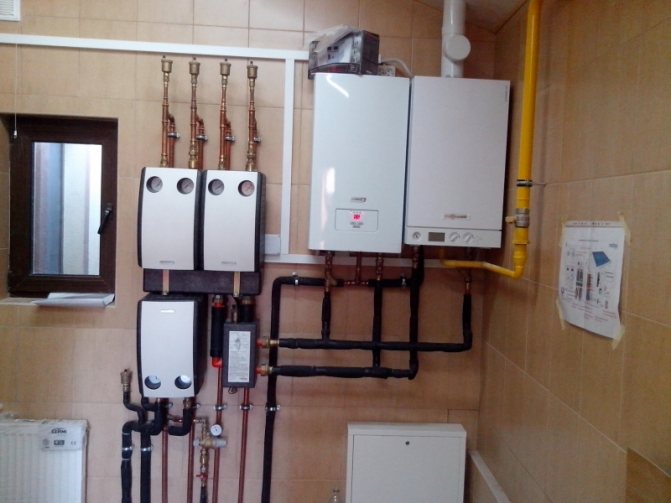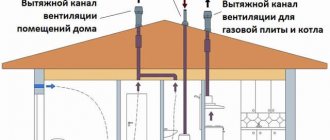A prescription for replacing a gas boiler may be natural wear of the heat exchanger, pipes and lines, obsolescence of automation and other inconsistencies with current safety standards.
The replacement procedure, if it is not a similar model of the same power, almost completely repeats the installation procedure: it is necessary to obtain permission - technical conditions, make a new project, install the boiler unit and invite specialists to connect it to the gas main.
Is it possible to replace a gas boiler yourself
According to current requirements, replacing a gas boiler is equivalent to redevelopment, therefore it is necessary to go through a full re-registration process. Nevertheless, the legality of the change depends on which new boiler unit you are replacing the old one with:
- when replacing with a similar a gas boiler of the same manufacturer, of the same model and capacity, there is no need to agree, and dismantling the old one and installing a new boiler can be done independently;
- when replaced with a similar power, but a different model, it is officially required to obtain an agreement and draw up a new project, since it contains the unique serial and serial numbers of the boiler, due to other characteristics, changes in the heating system may be required. However, some owners still change equipment arbitrarily, relying on the fact that checks often pay attention only to power. In rare cases, a fine is paid and a replacement is legalized.
In all other cases: when changing to another model of a different power, floor-standing to wall-mounted, including when replacing it with a more powerful one, even of a similar model, you need to go through the entire process of coordination and connection.
This is somewhat easier to do, since the heating system is already assembled, and changes in piping or wiring are usually not required. You can dismantle the old boiler and install a new one on your own, but to connect to the gas main and initial start-up, you must call certified specialists, otherwise the equipment warranty will be invalid.
To change a gas boiler to an electric one, you just need to apply for a disconnection from the gas main. Electric boilers with a capacity of more than 10 kW require easier approval from the local energy supervision services.

What documents regulate the replacement of boilers?
Gas heating equipment, if improperly installed, operated or maintained, is a source of danger. Therefore, its replacement is not just the purchase and installation of the required unit, but a whole procedure, which is regulated by a number of documents.
All the necessary information about replacing gas boilers is freely available. But sometimes it is not easy to find them, since the topic of gas equipment is regulated by dozens of domestic specialized documents. Among which are laws, SNiPs based on them, government decrees and so on.
But among them there are a number of documents that are more important to the consumer than all the others. Since the information provided in them will help you understand the nuances of replacing stakes, as well as protect your interests from possible wrong actions of representatives of Gorgaz.
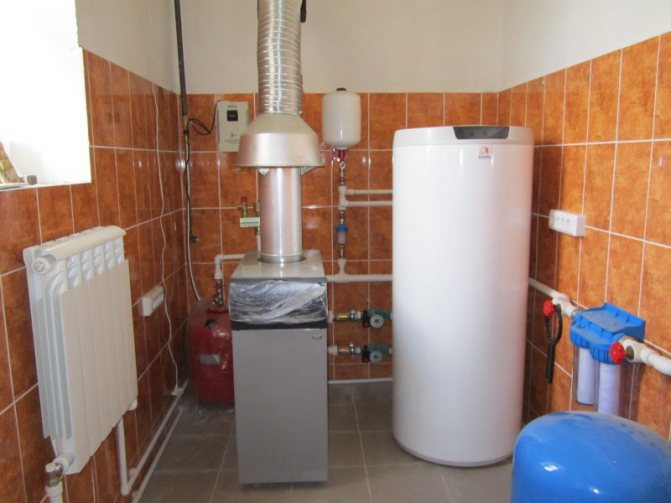

Replacing a gas boiler is a carefully regulated procedure that requires certain knowledge. As a result, there are many requirements, rules that must be strictly followed.
The most requested documents include:
- SNiP 2.04.08-87, which is called "Gas Supply";
- SNiP 42-41-2002 under the name "Gas distribution systems".
- GsRF dated December 29, 2004 No. 190-FZ (Urban Planning Code of the Russian Federation);
- PP RF dated 30.12.2013 No. 1314 (Resolution of the Government of the Russian Federation "On Amendments to the Rules for Connecting ... to Gas Distribution Networks");
- PP RF dated November 16, 2016 No. 1203 (Resolution of the Government of the Russian Federation "On approval of the rules for connecting ... to gas distribution networks");
- SNiP II-35-76, in which the procedure for connecting boilers is spelled out;
- Administrative Code of the Russian Federation of 30.12.2001 N 195-FZ (Code of Laws on Administrative Offenses).
It should be remembered that if necessary, you should use their latest versions, which contain current articles with the latest changes and additions.
How to replace a gas boiler in a private house: step by step instructions
Before registration, you need to make sure that the room, chimney and ventilation comply with the requirements of SNiP 42-01 and MDS 41.2-2000, which we have already described in the installation instructions. Otherwise, permission may be refused, given a list of necessary changes.
The procedure for replacing a gas boiler in a private house is as follows:
- We go to the local gas distribution organization (Gorgaz, Oblgaz, Rayongaz, etc.), register there and hand over installation application gas boiler. Required documents - passport and any evidence of your ownership of the house and adjacent territory. After submitting the application, the boiler will be queued for shutdown, and after a while it will be issued technical conditions (TU) - this is the permission. Until the technical specifications have been issued, you can start dismantling the boiler (independently or with the assistance of specialists).
- In the fire authorities or housing and communal services, we find out the contacts of a local organization that checks chimneys (or ventilation ducts, if it is an apartment in an apartment building). After inspection, specialists will issue conclusion on the proper condition of the chimney (or ventilation), otherwise they will give a list of necessary changes.
- When the TU is already on hand, we order project in the same "Gorgaz" or any design bureau entitled to carry out such work. To draw up a project, you will need data on the model of the gas boiler and meter.
- With the finished project, TU, conclusion on the state of the chimney (or ventilation), we again go to the local gas distribution organization, where we submit the project for approval, conclude an agreement with the gas workers for boiler maintenance. Now you can install the boiler on your own or with the involvement of specialists (the same local gas workers).
- The final step is to contact gas workers to receive installation work, connect the boiler to the gas main, perform the first start-up and commissioning. Upon completion of all work, a corresponding mark must be put in the boiler passport (without it, the guarantee for the boiler unit will not apply).
Registration of the replacement of a boiler unit takes from 1.5 to 3 months, it is the same for both a private house and an apartment. The procedure may differ slightly depending on the region and city, for example, an act of fire safety or the final approval of all work in the city administration may additionally be required. One of the organizations will notify you if necessary.
How to choose a room thermostat and save up to 30% per month on heating
What will be required for replacement?
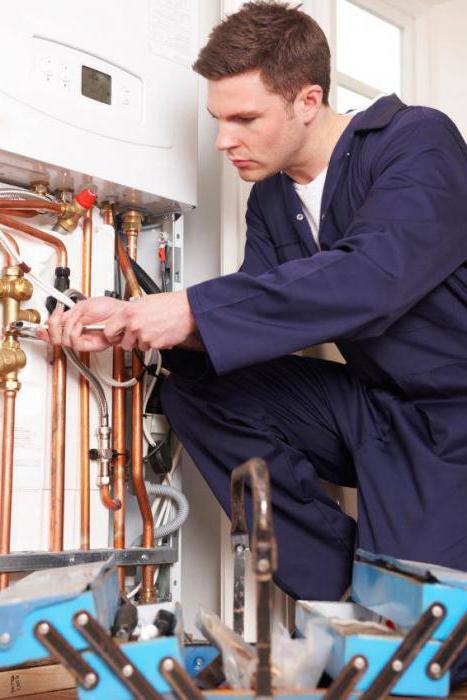

Replacing gas boilers requires the following equipment, accessories and tools:
- new gas boiler;
- bracket for hanging on the wall;
- ball valve - 3 pcs.;
- filters for water purification from impurities and debris - 3 pcs .;
- gas valve;
- gas meter;
- KTZ;
- gas alarm;
- three-core valve;
- Voltage regulator;
- UPS;
- anchor;
- metal sheets;
- requirements for connecting the boiler to gas and water supply;
- building level.
You can buy everything you need in any specialized store that sells heating systems.
Dismantling the old one and installing a new boiler on our own


- If there are no shut-off valves in front of the boiler, drain the coolant from the system.
- Disconnect the boiler from the gas main, make-up and heating system.
- Disconnect the chimney pipe from the boiler, if the model is wall-mounted, you can remove it together with the chimney by disconnecting it from the ventilation or the wall.
- Dismantle the boiler unit from the mountings (on wall-mounted models the screws of the mounting plate may be inside; to access them, you must remove the front panel).
The installation of a new boiler is carried out in the reverse order and differs somewhat depending on the model; a detailed algorithm with visual diagrams for modern models is always indicated in the operating instructions (passport) of the equipment.
Boiler room requirements
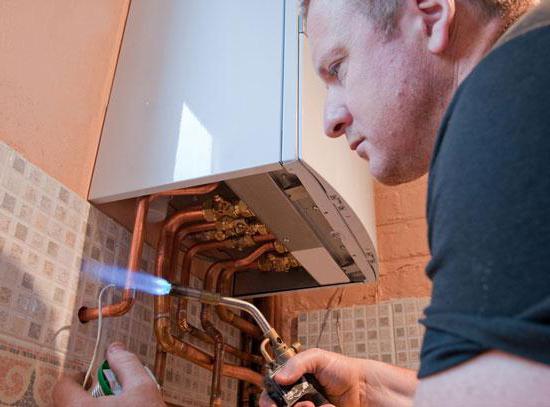

According to safety rules, gas heating equipment must be installed in a separate room with an area of at least four square meters. In addition, the boiler room must be equipped with a good ventilation system. The place for installing the boiler should be chosen smooth and heat-resistant.
The equipment must be installed in a location that is easily accessible. If it is of a suspended type, then special brackets are used for wall mounting.
If you live in an apartment, and you do not have the opportunity to allocate a separate room for the boiler, then it is not recommended to install it in the bathroom due to high humidity.
Penalties for self-change without approval
Replacing a gas boiler in a private house without permission and without drawing up a project is prohibited by law - Art. 7.19 of the Code of Administrative Offenses of the Russian Federation "Unauthorized connection and use of electrical, thermal energy, oil or gas". The amount of the fine is from 10 to 15 thousand rubles, in the event of an emergency, criminal liability is possible.
They can find a replacement during the next scheduled check: at least, there will be no stamp in the boiler's passport indicating that the specialists have carried out commissioning. Then the gas distribution company terminates the contract, disconnects the house from the gas main, and imposes fines.
Nevertheless, in most cases, gas workers do not pay attention to the changes made or turn a blind eye even to serious violations, it is often possible to come to an agreement with the workers. Many owners of private houses, especially in rural areas, actively use loyalty, but what works today may be interrupted tomorrow, and it is impossible to legalize an already installed gas boiler. Therefore, despite the huge bureaucracy, we recommend that you initially draw up a replacement in accordance with all the rules, especially since the process can be entrusted to specialists for relatively little money.
Boiler installation instructions


If you have pendant-type equipment, the first step is to mount the bracket. For its fastening, anchors are used with a firm fit. In order for the boiler to hang evenly, it is recommended to use a building level when performing work. If in your home the walls are made of flammable materials, then they are sheathed with metal sheets. If the heating equipment is of floor type, then no additional measures are required during installation. It is simply installed in a prepared place. It is worth noting that if there is any other gas equipment in the boiler room, then there must be at least 20 centimeters between it and the boiler.
It is necessary to connect to the water supply system through mesh filters, which will prevent debris from entering the heat exchanger. In this case, the pipes should be connected to the equipment through a ball valve.It is also recommended to use a special filter to purify water from impurities. This will extend the life of the equipment.
The connection to the gas pipeline is carried out through a special valve, a gas meter and a thermal shut-off valve. Also, a gas alarm must be installed in the boiler room.
If the boiler is supposed to be connected to the electrical network, then a three-core cable with a plug is used for this. In this case, the socket must be grounded. It is recommended to use a voltage stabilizer equipped with an autonomous power supply for connection. This will protect the boiler from power failures.
If you have closed-type heating equipment, then it must be connected to the ventilation system. This is necessary to remove combustion products from the boiler. For connection, a coaxial pipe is used, which will be responsible not only for the emission of carbon monoxide gases, but also for supplying fresh air to the combustion chamber.
At the final stage, after connecting the equipment to all communications, the heating system is filled with water and the equipment is checked for operability. This is how any type of boiler can be replaced, regardless of the model.
The cost of the work of specialists
Prices for a full replacement, paperwork and commissioning work depend on the type and model of the boiler, the region and the company providing the services. In Moscow and the Moscow region it is about 8-22 thousand rubles, for St. Petersburg - 6-15 thousand rubles, for the regions - 4.5-12 thousand rubles. About half of the cost is spent on dismantling the old and installing a new boiler unit, almost half on commissioning.
Please note that the procedure for completing the necessary documents is not always included in the replacement service.
Gas boilers
Installation procedure for a new heater
Federal Law No. 190 lays down the rules for installing a new boiler for multi-storey buildings. In an apartment connected to a centralized mains, a complete replacement of the boiler is unacceptable. An exception is made by individual sources specified in the Government Decision No. 307.


When installing a floor-standing boiler, a foundation is installed instead of a wall-mounted one.
For private houses, the requirements are not so stringent - gas specialists and owners can carry out installation work. Independent events are carried out as follows:
- Installation of a non-combustible board for wall-mounted appliances and a foundation - for floor-standing appliances.
- Control of the unit location relative to the wall - with a gap of 20-30 cm.
- Connection of heating and water supply only after the installation of the boiler.
- Equipping the water supply pipe from the central system with a filter to protect the heat exchanger from clogging.
- Sealing connections with a special tool or fum tape.
- Connecting the unit to the 200 V mains and grounding the line.
- Chimney connection of classic equipment with a standard chimney, turbocharged - with a coaxial pipe.
- Checking the system for leaks. Water is poured into the line and the pressure readings are checked at 0.8-1.8 bar.
For additional safety, a voltage stabilizer is connected to the boiler device.
Specificity of replacing a heating furnace with AGV


When replacing a gas oven with autonomous heating, new technical specifications from the gas economy are needed
Old AOGV with one circuit can be replaced with two-circuit modifications if they are excessively powerful, incompatible with water heated floors (the return flow is mixed with a valve). Work is also carried out if the equipment is not equipped with weather-dependent automation.
The procedure for replacing a heating gas furnace with AGV is legally established - only with the receipt of new technical conditions:
- Contacting Gorgaz to obtain documentation.
- Writing an application in 2 copies for technical conditions, if they were not received earlier. The application specifies the data of the citizen, the planned commissioning time, the maximum capacity of the equipment.
- Submission of an application for technological connection in the presence of technical specifications in free form. The details of the owner, the name and location of the facility, the type of gas consumption, the terms of construction and commissioning, the planned capacity, the number and date of receipt of the technical specifications are indicated.
- Appendix to the text of the application of accompanying documents. You need a passport, a certificate of ownership of land and a house, a plan and topographic map of the site, settlement documents.
- Installing new equipment and connecting it to the system.
Installation work should only be carried out by specialists.
